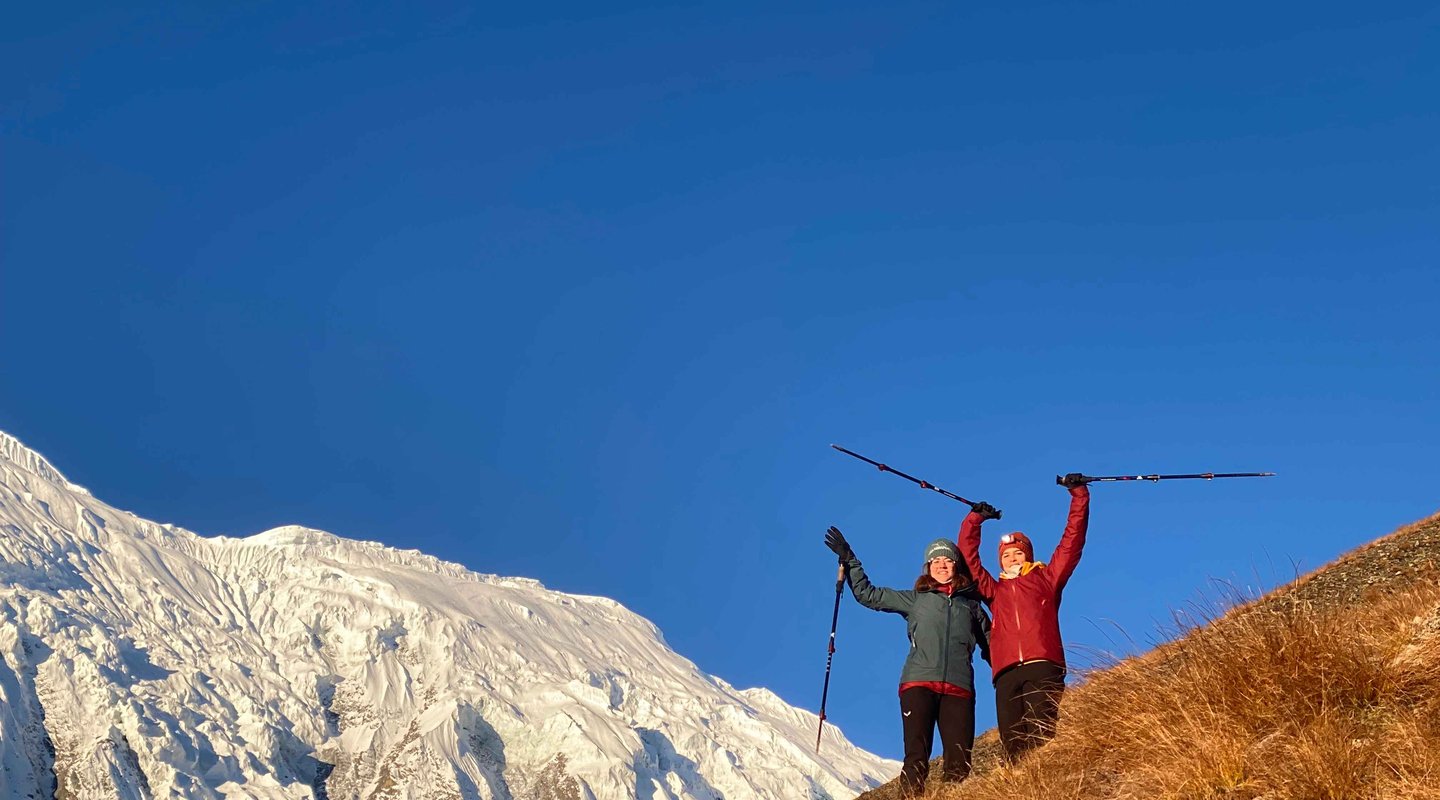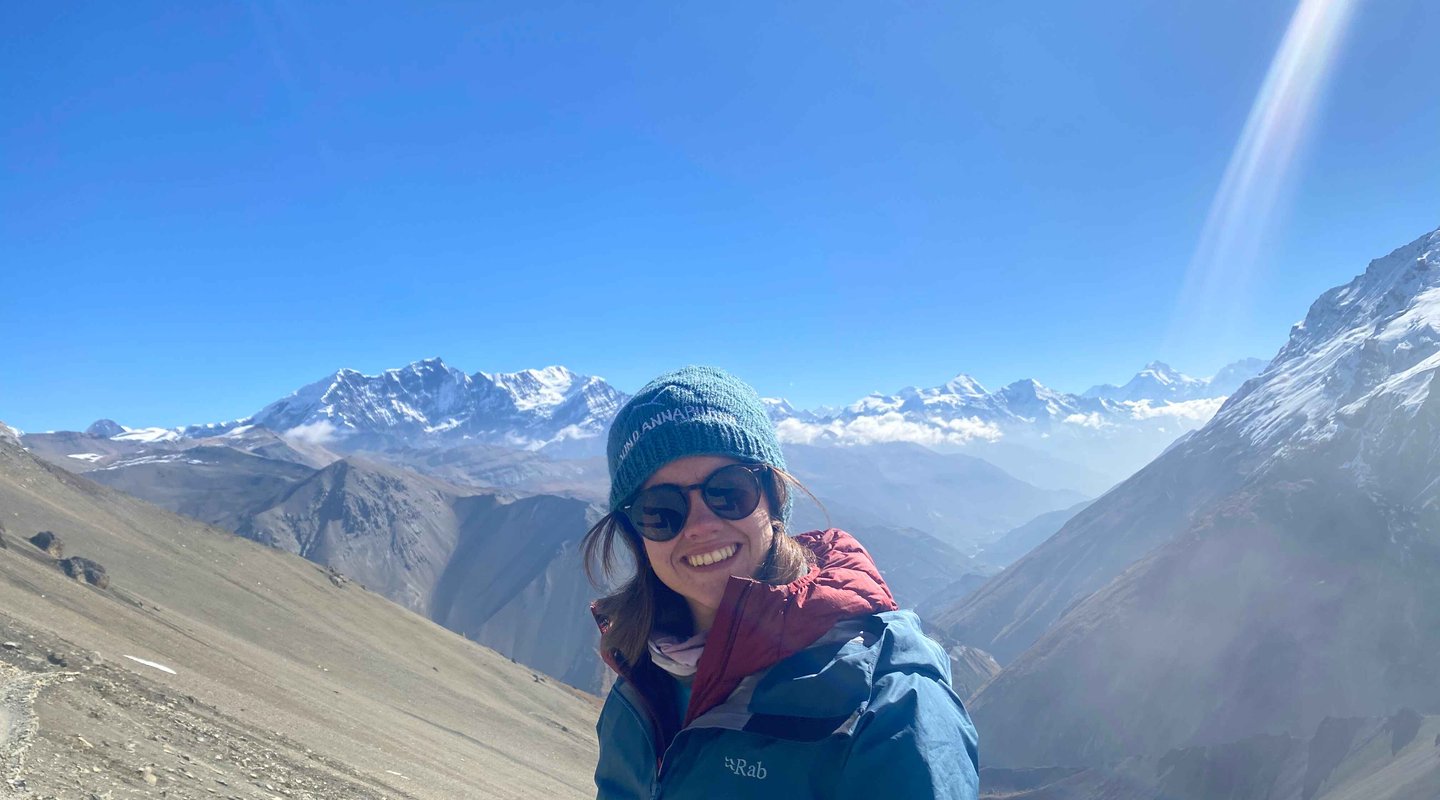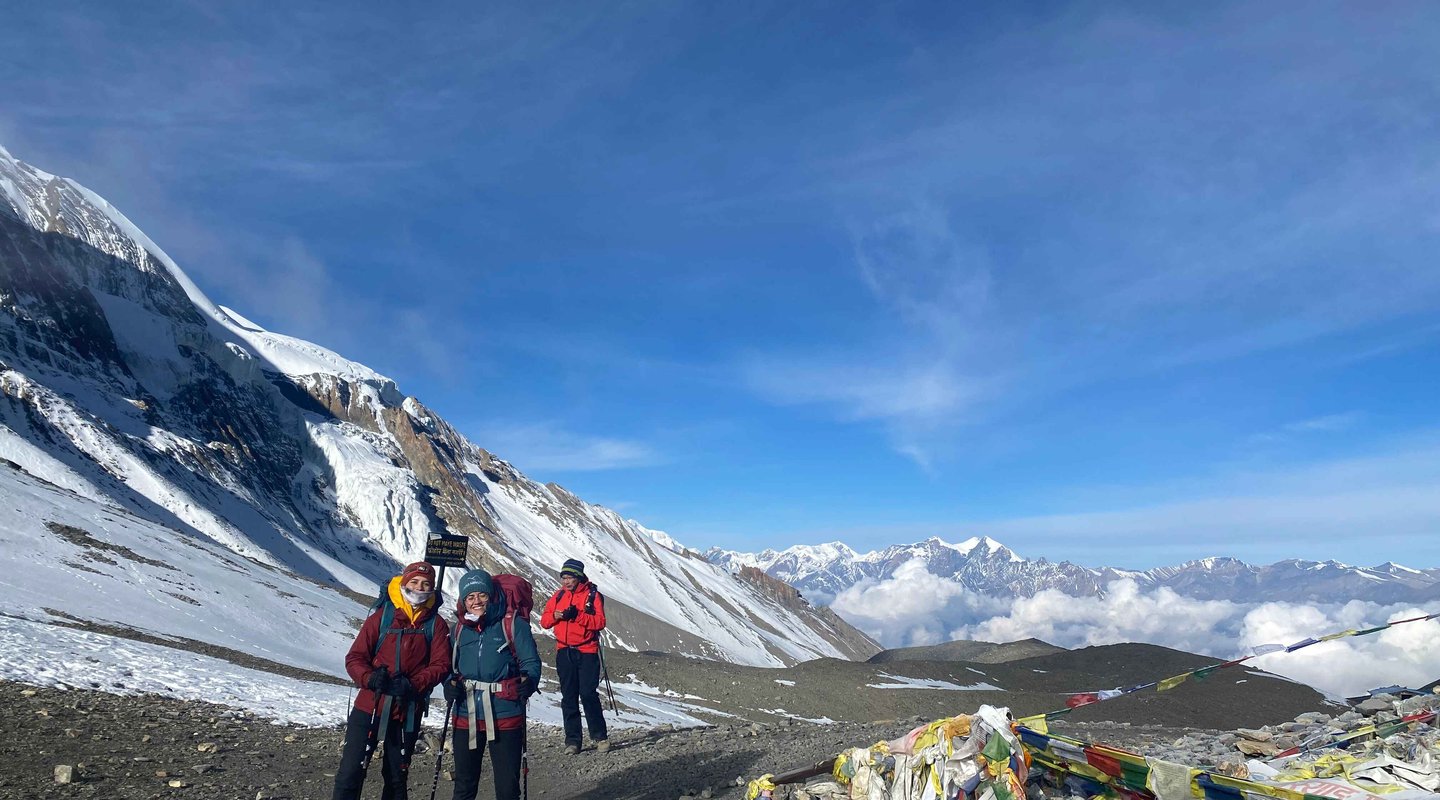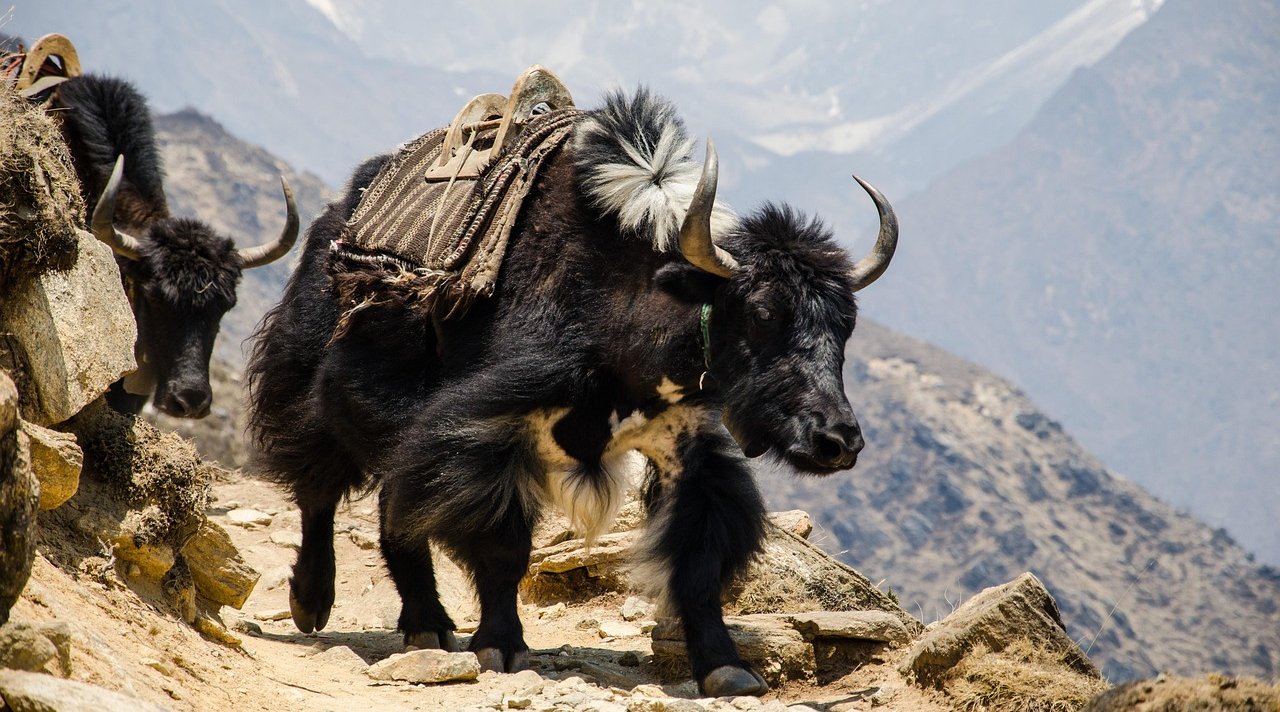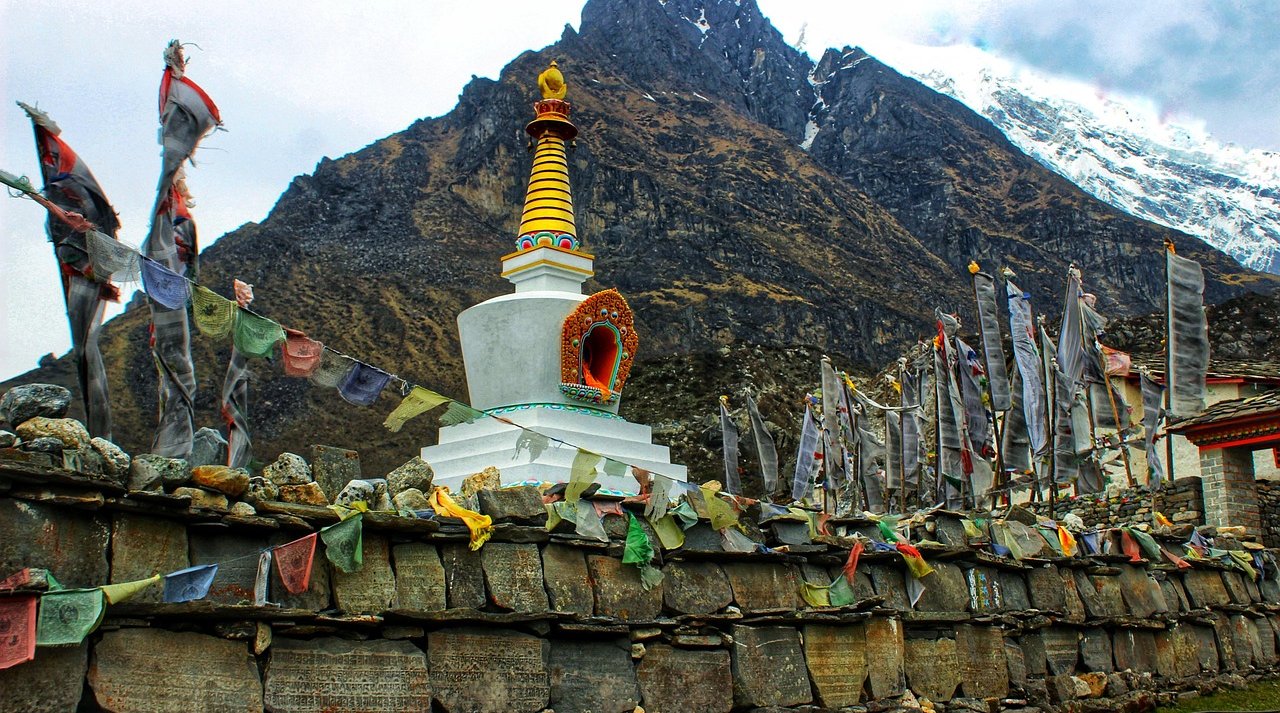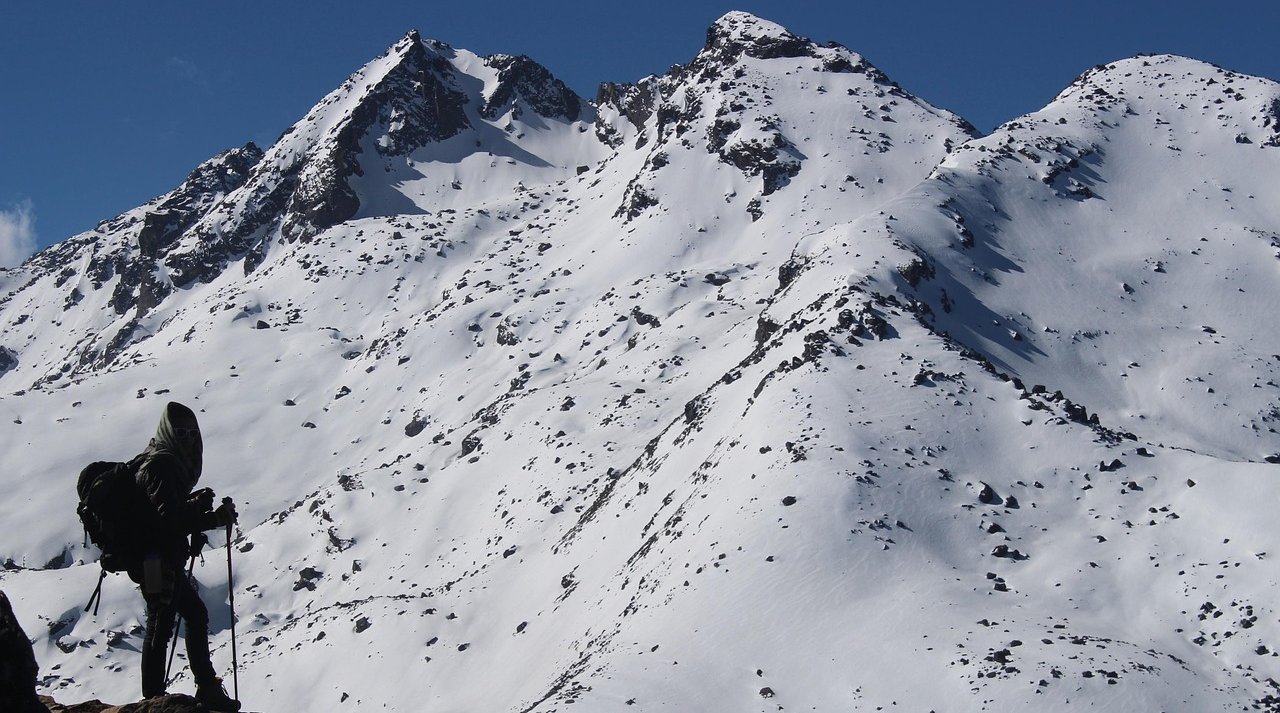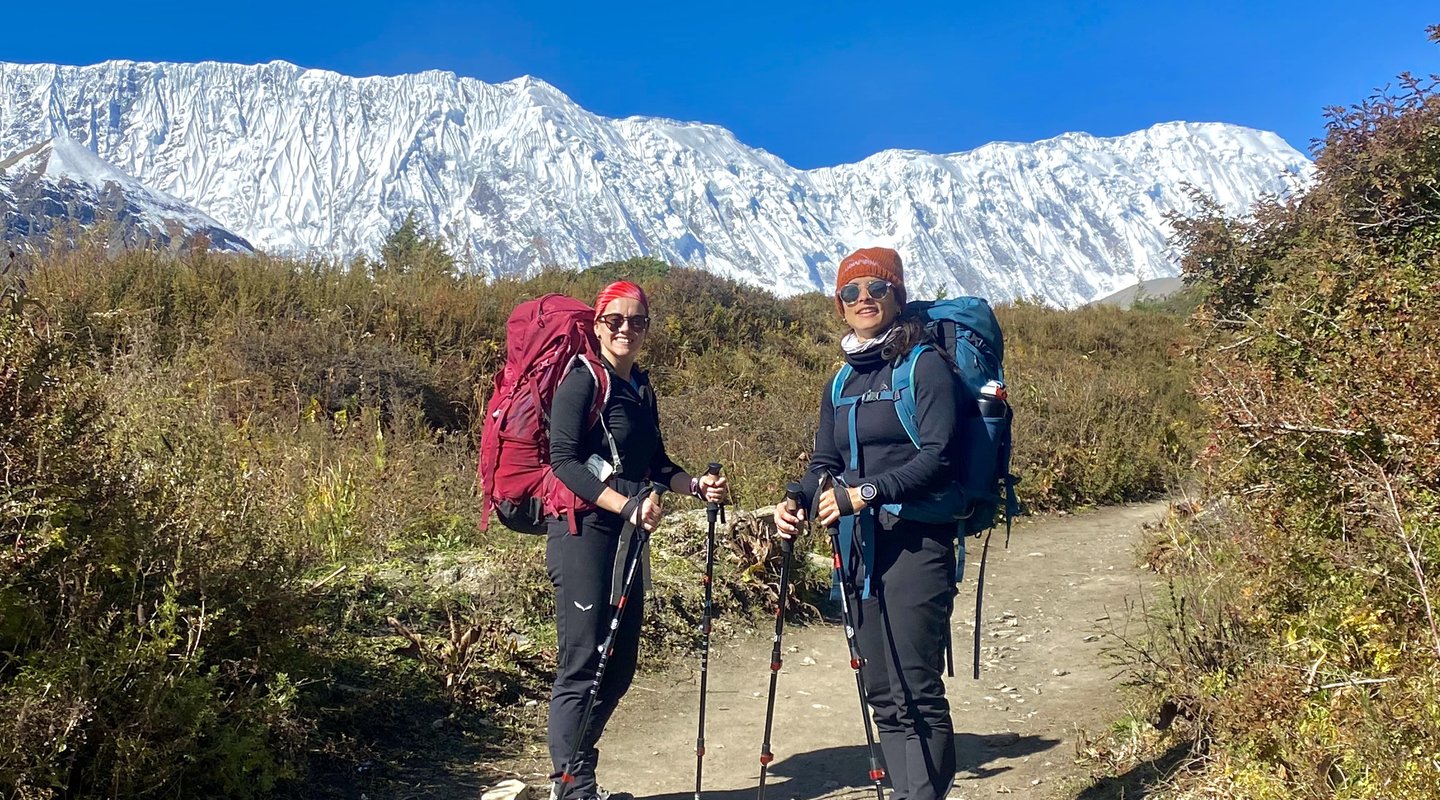
The Annapurna Circuit Trek is one of the most loved and popular treks in Nepal. This circuit typically takes around 14 days to complete, starting at an altitude of about 800 meters in Besisahar and rising to the highest point called Thorong La Pass (5,416 m/17,769 ft), giving you a challenge related to altitude acclimatization.
The Annapurna Circuit Trek with a complete 14-day itinerary for beginners offers you an opportunity to immerse yourself in the rich culture and biodiversity of the Annapurna region, where you will be encapsulated by the diverse landscapes of lush subtropical forests, terraced fields, and high-altitude terrains. You will encounter traditional local villages of the indigenous communities, such as Gurung, Manangi, and Thakali, along the route, offering you their vibrant cultural traditions and hospitality. The Annapurna Circuit Trek offers you the breathtaking views of peaks including Annapurna I, Annapurna II, and Machhapuchhre, which are over 8000 meters.
The Annapurna Circuit Trek is one of the most accessible trekking routes in Nepal. This circuit offers you the unique local villages and diverse terrains, from lush subtropical forests to high-altitude deserts. A 14-day itinerary will provide you ample time for gradual ascent and acclimatization, properly giving you time to adapt to the varying altitudes without extreme exhaustion. You will get teahouses for your accommodation, which are very comfortable, offering you facilities of portable toilets, meals, etcetera. The Annapurna Circuit is actually less rugged in comparison to other remote treks, which makes it an ideal choice for beginners.
Max elevation: 1335 m
Duration: 30-minutes drive
Distance: 6 kilometer
One of our representatives will pick you up from the Tribhuvan International Airport and will take you to the hotel. After reaching the hotel, you can check into your room and freshen up. In the evening you can take a stroll around the Thamel area, and you can buy your gear or rent it in Thamel. You will find a number of shops and restaurants where you can enjoy your dinner.
Max elevation: 1100 m/3608 feet
Duration: 8 to 9 hours
You will travel from Kathmandu to Syange by taking a long drive passing through Besisahar. You will encounter villages, agricultural farms, shops, and restaurants along the road. You will cross the Marshyangdi River by leaving the Tribhuvan Highway and joining the Prithivi Highway. After the drive of about 5 to 6 hours, you will reach Besisahar.
Although you will have a bumpy and dusty ride during the bad season, the stunning views of the waterfalls, rivers, and your first glimpses of the majestic snow-capped mountains of Annapurna will keep you awestruck along the ride.
You will pass by the traditional villages such as Bhulbhule, which is near the Marshyangdi River, and Ngadi village, and finally, after an 8 to 9-hour drive from Kathmandu, you will reach Syange village.
Max elevation: 2,160 m
Duration: 5 to 6 hrs
This is the starting point of your Annapurna Circuit Trek. You will walk through the forest trails of bamboo, rhododendrons, and pines. You will see the terraced and cultivated fields of potatoes, wheat, and other grains. You will cross fir and pine trees through Dharapani, and after the long trek of five to six hours, you will reach Bagarchhap.
Max elevation: 2,710 m
Duration: 5 to 6 hrs
Chame is the district headquarters of Manang district. From Besisahar, you will be heading to the Danaque village, walking through the lush pine forests. You will enjoy the breathtaking views of the mountains of Annapurna II, Annapurna IV (7,525 m), Mt. Manaslu, and Lamjung Himal. You will cross through a few Tibetan villages, such as Thanchok and Koto, trekking to the sparse and barren landscapes. Finally, after a short hike up the hill, you will reach Chame, which is one of the largest villages of the Annapurna Circuit.
Max elevation: 3,300 m/10,826 ft
Duration: 5 to 6 hrs
Distance: 13.2 km/8.2 miles
You will begin your trek towards the suspension bridge of the Marsyangdi River after breakfast. You will get to see a curved rock called Paungda Danda Rock, which is considered to be sacred by the local people. You will be amazed by the clear views of Annapurna II and Pisang Peak.
After a walk of an hour, you will reach Barthang village, which is known to have the largest apple orchard. You will get to taste various delicacies made from apples, such as apple strudel, apple pie, apple cider, apple crumble, etc.
Then you will walk to the Swargadwari Bridge and come close to Dukure Pokhari by entering a U-shaped valley where you will see the dramatic transformation from green valleys and rocky sides on the right.
You will reach the ancient village, Pisang, by walking on the easy trails divided into Lower Pisang and Upper Pisang. You will get the spectacular views of the Annapurna mountain ranges and Pisang Peak. Finally, after a 30 to 40-minute hike, you will reach Upper Pisang, which is a village enriched with Tibetan Buddhist culture.
Max elevation: 3,540 m/11,300 ft
Duration: 5 to 6 hrs
Distance: 17 km/10.6 miles
You will be trekking through the upper section of Pisang. You will get 2 routes that will lead you to Manang. One route is scenic but takes a long time, giving you a tough time, while the other route will require steep climbing, but you will get to see the beautiful views of Annapurna.
You will reach an authentic Tibetan village called Geru after two to three hours of walking. You will see the stunning landscapes, snow-capped mountains, and a river below while continuing your hike to Ngawal.
While descending to a village called Braga, you will see the transition of terrain into drier and rockier terrain, including yak pastures and alpine fields. You can visit a gompa named Samgag Sampling Monastery at Braga village, which is believed to be more than 900 years old and it has unique houses stacked open one at top of the other, each featuring an open veranda. You will see the spectacular views of the Annapurna range, Gangapurna peak, and Tilicho peak while hiking to Manang.
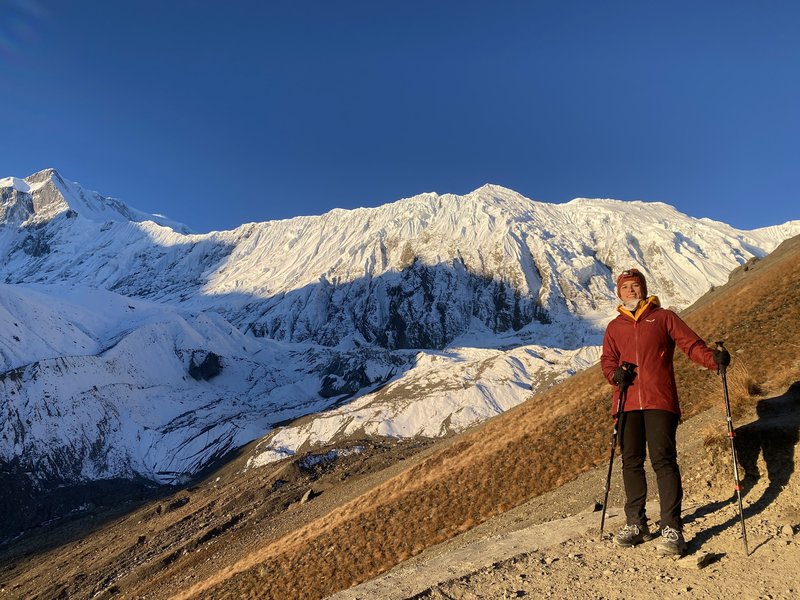
It is crucial that you acclimatize at Manang before ascending to the higher altitudes during the Annapurna Circuit Trek. You can plan Manang rest day activities such as going for light hikes and exploring the Manang Valley. To further acclimatize or to adapt to the altitude, you can take a short hike to Khangsar and to Gangapurna Tal. It will take 30 to 40 minutes from Manang to reach the lake. If you want better views of the Gangapurna glacier, then you can climb a bit higher.
You can visit Barge Monastery, which is the largest monastery in Manang, if you take an interest in learning religious things. Similarly, you can hike to Milarepa Cave, which lies above the Braga village. For this you need to hike on a steep, rocky cliff, which will be exhausting for you, but it will offer you the majestic views of Mount Annapurna III and the Manang Valley itself.
You can plan your Manang rest day activities, including the exploration of the village after returning to Manang and interaction with the locals, and learn about their rich culture. You can take a walk through the flat-roofed stone houses, which are separated by narrow alleyways, and through the lodges, shops, and cafes. You may also consider visiting the local health post for a quick health checkup. You may also take a Himalayan Rescue Association course about Acute Mountain Sickness (AMS) in the evening time at Braga village.
Max elevation: 4,020 m/13,123 ft
Duration: 4 to 5 hr
Distance: 11 km
You will hike, passing through the Kharsang Khola, with a slow ascent to Yakkharka. You will get to see the beautiful Gangapurna and Annapurna in a close view, passing through stone walls and farmlands. Now you will be taking a peaceful trail without any traffic of vehicles, as the dirty route ends there.
You will head over to a small village called Tengi, which lies between the routes of Yak Kharka and Tilicho Base Camp. You will pass through the alpine shrubs with only a few trees at Gunsang while continuing your hike. You will get to enjoy the beautiful view of Chulu East and Chulu West.
This will be an uphill ascent through the juniper forests and Alpine pastures where you will see yaks grazing and also horse pastures. Then you will need to cross a wooden ridge at last, and finally, you will arrive at Yak Kharka.
Max elevation: 4,450 m/14,599 ft
Duration: 3 to 4 hrs
Distance: 8 km
You will be hiking on rocky meadows over a small Marshyangdi river called Kone Khola with a mild ascent. After a walk of an hour, you will reach Ledar. You will continue your hike, passing the tea shops at Deurali, and following Jarsang Khola, you will reach Thorong Phedi.
While hiking along the Thorong River, you will get to see panoramic views of Annapurna II and Gangapurna Peak. You will find rugged terrain uninhabited and very much different than the lush lowlands you passed. You may also get to see the famous blue sheep, snow leopard, and Lammergeyer (bearded vulture).
You can decide whether you want to stay at Thorong Phedi or at Thorong High Camp depending on your preference, as you may sleep better at Thorong Phedi, being at a lower altitude, and you might find it easier staying at Thorong High Camp (4,925 m/16,158 ft) for the next morning's trek.
Note: It will take 1 to 1.5 hours to reach Thorong High Camp (4,925 m/16,158 ft), which is 300 to 400 meters higher in altitude than Thorong Phedi.
Max elevation: 3,760 m/12,623 ft
Duration: 7 to 8 hrs
Distance: 15.6 km/9.6 miles
This is going to be the most difficult journey for you, as you will be crossing Thorong La Pass (5,416 m/17,769 ft), which is the highest point of the Annapurna Circuit Trek and is actually one of the highest passes in the world. You should start your trek very early in the morning, as this will be the most favorable time. You can start your hike around 4:30 AM to avoid strong winds.
If you are starting from Thorong Phedi, then you need to walk for around 2 hours to reach Thorong High Camp (4,925 m/16,158 ft), and the terrain will be steep and icy depending on the season, and you will find difficulty in breathing because of the thinner air. However, you will get to enjoy the beautiful views of Khatungkang, Yakawa Kang, and Thorung Peak.
Then you will reach the highest point of the Annapurna Circuit Trek, Thorong La Pass (5,416 m/17,769 ft) after hiking for 3 to 4 hours. You will find the pass being decorated with money stones and prayer flags, including the shrines, giving a beautiful touch to the religious aspect. Reaching Thorong La Pass (5,416 m/17,769 ft) will be a rewarding moment because of the stunning views of the Annapurna range.
You will make your way to the Muktinath pilgrimage site (3,760 m/12,623 ft) which is a famous temple for Hindus and Buddhists in the world, descending along the Thorong Khola and passing through Chambar Bhir with the majestic view of the 7th highest peak in the world, Mount Dhaulagiri.
Max elevation: 2,720m
Duration: 5 to 6 hrs
Distance: 16 to 17 km
You will start your trek to Jomsom from the Muktinath pilgrimage site (3,760 m/12,623 ft) known for 108 sprouts and an eternal flame burning for more than 2000 years.
You will hike, passing through the deepest gorge in the world, Kali Gandaki, and after 3 to 4 hours of hiking, you will reach Kagbeni. You will see the dark tunnels, alleys, and closely packed mud houses, rich in the horticulture industry, giving you the ambience of a medieval village. You will do your final stretch at Ekla Bhatti before reaching Jomsom, which is the end of your Annapurna Circuit Trek.
Max elevation: 850 m/ ft
Duration: 7 to 8 hrs
This will be your road trip, taking you through Tatopani, famous for natural hot springs, to take you to Pokhara. Its water is believed to be a cure for some skin diseases.
After arriving at Pokhara, you can check in your hotel room at Lakeside and freshen up. You can dine at the restaurants or stroll around the Lakeside in the evening. some spare time.
Note: You can make your journey to Pokhara from Jomsom directly as well. One of the convenient ways for Jomsom to Pokhara transport is the airway. You can book a flight that is for about 20 minutes. But flights get cancelled quite often because of the weather.
You can do a lot of exciting and enjoyable activities at Pokhara. You can take a visit to the famous Phewa Lake and even take a boat trip over there and visit Tal Barahi Temple, which is in the center of the very lake.
You can go for a short hike to Sarangkot early in the morning to get the sunrise and see the beautiful view of Pokhara Valley from there. You can take in the surreal feeling of Mount Machhapuchhre and even do some photography sessions there. You can go through the shops and do some shopping for souvenirs to take to your home.
Lastly, you can just relax after the exhausting Annapurna Circuit Trek and reflect on your journey about how you faced the challenges and actually made it.
Max Elevation: 1,350 m/4,450 ft
Duration: 6 to 7 hrs
Distance: 200 km
After breakfast, you will head back to Kathmandu by a tourist bus, passing through the Marshyangdi and Trishuli rivers. Once you arrive at Kathmandu, you can take a rest in your hotel and later stroll around the Thamel area, and this is the end of your journey to the Annapurna Circuit Trek.
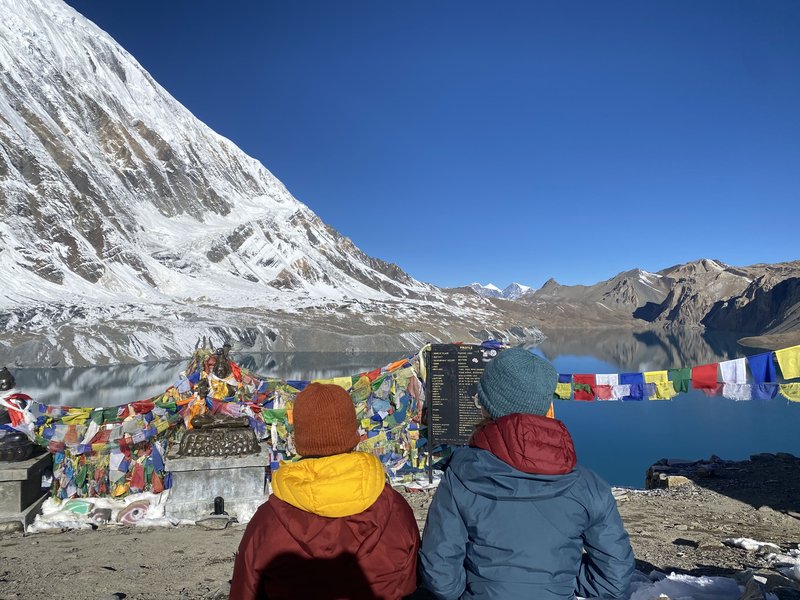
The Annapurna Circuit Trek will require long hours of walking at different terrains at varying altitudes. So we advise you to start preparing for the trek at least 3 to 6 months before you hike on the Annapurna Circuit.
Train your body with cardiovascular activities like cycling, swimming, running, and hiking to build your stamina. Start your strength training exercises to build your core and upper strength to navigate through the rugged terrain carrying your backpack.
You can do short hikes and gradually increase your elevation gain, including your hiking intensity, and train yourself to improve your balance and adaptability.
Pacing during the Annapurna Circuit Trek is crucial, so take breaks and do proper acclimatization. Your Annapurna Circuit Trek daily distance should be 170 to 200 kilometers a day. Do not forget to hydrate yourself, and do not ignore your body's signs to those signs become life-threatening.
The Annapurna Circuit Trek Elevation Gain (10,107 meters/33,159 feet), which requires you to do proper acclimatization during the Annapurna Circuit Trek, is one of the most essential things you should be doing because there will be reduced oxygen levels in the higher regions, and your body will find it difficult to adjust to such significant change, causing severe altitude sickness. So you can follow a simple principle known as “climb high, sleep low,” meaning you ascend to the higher elevation during the daytime but descend to lower elevation to sleep. This method will allow your body to acclimatize properly without giving you stress about sleeping in lower oxygen levels at higher altitudes. You can plan to hike to higher destinations like Khangsar during your stay in Manang or just pass Manang at about 4,200 meters, planning to return at night time to sleep, which will be so effective for your body to train it to adjust to the higher altitudes.
Additionally, make the Annapurna Circuit Trek acclimatization schedule like acclimatizing after every 600 to 800 meters above 3,500 meters. Especially, make an acclimatization plan at Manang and before crossing the highest point of the Annapurna Circuit, the Thorong La Pass (5,416 m/17,769 ft).
For the Annapurna Circuit Trek, you will need the following permits, which you can get from the Nepal Tourism Board with your passport and passport-sized pictures.
Annapurna Conservation Area Permit (ACAP)
25 USD for other foreigners
8 USD for SAARC countries
Trekkers Information Management System Card (TIMS)—20 USD per person
It is not a legal compulsion to get a guide for the Annapurna Circuit Trek, but as a beginner, you will benefit if you hire a guide.
Cost of Guide 20 to 25 USD per day
Spring (March to May) and autumn (September to November) are the best seasons for the Annapurna Circuit Trek . You can expect stable weather patterns and moderate temperatures ranging from 10° to 20°C in the lower levels, providing you with clear skies.
Spring is the season of colors and blooming rhododendrons, diverse flora that will offer you stunning visuals.
Autumn is the best season for photography and sightseeing, offering you vibrant views of snow-capped mountains with excellent visibility.
For beginners, the monsoon season (June to August) can be risky and exhausting because of the poor trail conditions and increased risk of landslides due to heavy rainfall.
For beginners, winter (December to February) will not be a favorable season because of the freezing and harsh temperatures, especially at higher altitudes.
Thus, spring and autumn are the most optimal seasons for you, as they allow for gradual Annapurna Circuit elevation gain, provide safety and comfort, and offer cultural insights, enhancing your overall experience during the Annapurna Circuit Trek. You can also check out our article about to get the thorough guide about the seasons you might prefer for yourself to embark on.
You can get altitude sickness while ascending to high altitudes above 8,000 feet (2,400 meters), where there are lower oxygen levels. Your symptoms of altitude sickness can be mild or severe, which often include nausea, dizziness, headache, loss of appetite, and sleep disturbances. Your Altitude Sickness can turn into severe conditions known as High Altitude Pulmonary Edema (HAPE) or High Altitude Cerebral Edema (HACE). These are life-threatening conditions, so it is crucial that you give your body the time to adjust to the significant change in the oxygen levels and ascend gradually.
After reaching 8,000 feet, we advise you to not increase your altitude more than 1,000 feet (300 meters) per day. Make a plan of Manang rest day activities for proper acclimatization on the Annapurna Circuit to avoid overexertion. Additionally, your body needs proper hydration, so drink at least 3 to 4 liters of water every day, as it will enhance your oxygen transport and maintain proper bodily functions as well. More importantly, do not consume any alcohol and avoid smoking. Furthermore, do recognize your bodily signs to not let your condition turn fatal.
You need to understand and respect the cultural etiquettes of the local people during the Annapurna Circuit Trek. The traditional villages inhabited by Gurung, Manangi, Tamang, and Thakali people have their own unique and rich cultural practices and traditions. You need to learn their etiquette to foster positive interactions with the local people. One of the etiquettes would be greeting local people by saying ‘Namaste’ and following their custom that you should use your right hand when you offer or receive items because they consider the left hand unclean. You can also read our article to get insight into the culture of the locals of Annapurna Circuit
Be aware of the local sensibilities by wearing modest clothes, especially while interacting with people during the ceremonies and gatherings and visiting religious places. Even when taking photographs, you need to ask their permission, as it is respectful. More importantly, it is crucial that you often talk about being sensitive while engaging in the conversations with the local people and do not let any culturally or politically charged topics enrage them.
You will find a variety of traditional dishes, mainly dal bhat (rice and lentils) and momo (dumplings). So you need to showcase your appreciation for the meals and their hospitality and your enjoyment of their cooking by eating everything that is served to you on your plate. Being respectful and polite while engaging in the conversations with the local people will enrich your own experience during your Annapurna Circuit 14-day itinerary trek.
Please feel free to contact us at [email protected] or WhatsApp us at +9779801127073.
package/annapurna-circuit-trek-14-days-himalayan-hero-adventure/
